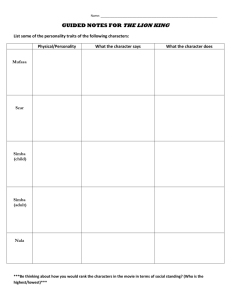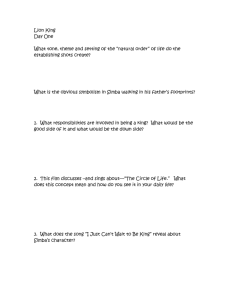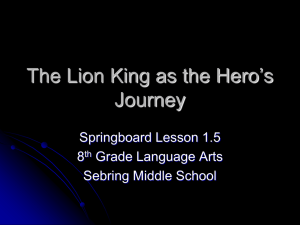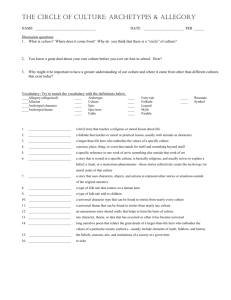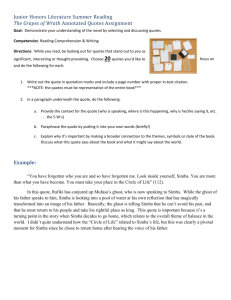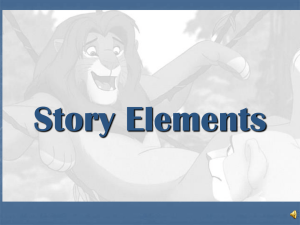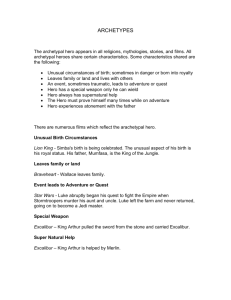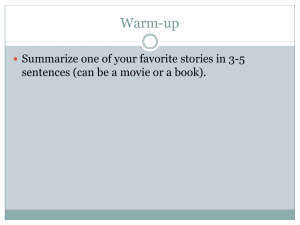Document 10466716
advertisement
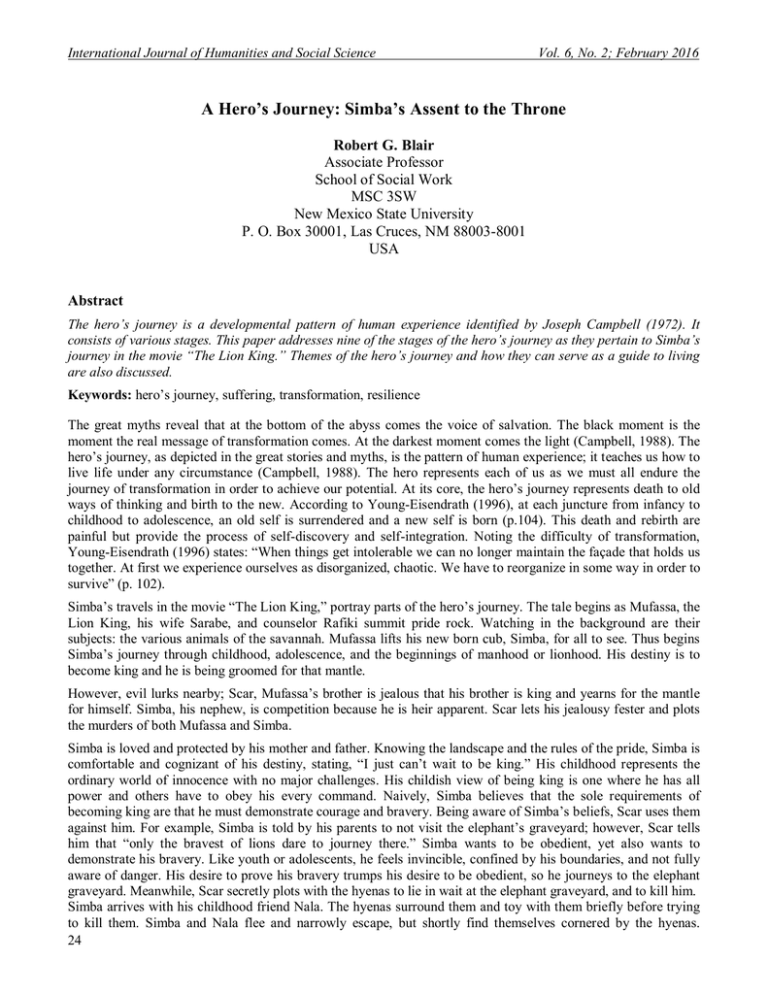
International Journal of Humanities and Social Science Vol. 6, No. 2; February 2016 A Hero’s Journey: Simba’s Assent to the Throne Robert G. Blair Associate Professor School of Social Work MSC 3SW New Mexico State University P. O. Box 30001, Las Cruces, NM 88003-8001 USA Abstract The hero’s journey is a developmental pattern of human experience identified by Joseph Campbell (1972). It consists of various stages. This paper addresses nine of the stages of the hero’s journey as they pertain to Simba’s journey in the movie “The Lion King.” Themes of the hero’s journey and how they can serve as a guide to living are also discussed. Keywords: hero’s journey, suffering, transformation, resilience The great myths reveal that at the bottom of the abyss comes the voice of salvation. The black moment is the moment the real message of transformation comes. At the darkest moment comes the light (Campbell, 1988). The hero’s journey, as depicted in the great stories and myths, is the pattern of human experience; it teaches us how to live life under any circumstance (Campbell, 1988). The hero represents each of us as we must all endure the journey of transformation in order to achieve our potential. At its core, the hero’s journey represents death to old ways of thinking and birth to the new. According to Young-Eisendrath (1996), at each juncture from infancy to childhood to adolescence, an old self is surrendered and a new self is born (p.104). This death and rebirth are painful but provide the process of self-discovery and self-integration. Noting the difficulty of transformation, Young-Eisendrath (1996) states: “When things get intolerable we can no longer maintain the façade that holds us together. At first we experience ourselves as disorganized, chaotic. We have to reorganize in some way in order to survive” (p. 102). Simba’s travels in the movie “The Lion King,” portray parts of the hero’s journey. The tale begins as Mufassa, the Lion King, his wife Sarabe, and counselor Rafiki summit pride rock. Watching in the background are their subjects: the various animals of the savannah. Mufassa lifts his new born cub, Simba, for all to see. Thus begins Simba’s journey through childhood, adolescence, and the beginnings of manhood or lionhood. His destiny is to become king and he is being groomed for that mantle. However, evil lurks nearby; Scar, Mufassa’s brother is jealous that his brother is king and yearns for the mantle for himself. Simba, his nephew, is competition because he is heir apparent. Scar lets his jealousy fester and plots the murders of both Mufassa and Simba. Simba is loved and protected by his mother and father. Knowing the landscape and the rules of the pride, Simba is comfortable and cognizant of his destiny, stating, “I just can’t wait to be king.” His childhood represents the ordinary world of innocence with no major challenges. His childish view of being king is one where he has all power and others have to obey his every command. Naively, Simba believes that the sole requirements of becoming king are that he must demonstrate courage and bravery. Being aware of Simba’s beliefs, Scar uses them against him. For example, Simba is told by his parents to not visit the elephant’s graveyard; however, Scar tells him that “only the bravest of lions dare to journey there.” Simba wants to be obedient, yet also wants to demonstrate his bravery. Like youth or adolescents, he feels invincible, confined by his boundaries, and not fully aware of danger. His desire to prove his bravery trumps his desire to be obedient, so he journeys to the elephant graveyard. Meanwhile, Scar secretly plots with the hyenas to lie in wait at the elephant graveyard, and to kill him. Simba arrives with his childhood friend Nala. The hyenas surround them and toy with them briefly before trying to kill them. Simba and Nala flee and narrowly escape, but shortly find themselves cornered by the hyenas. 24 ISSN 2220-8488 (Print), 2221-0989 (Online) ©Center for Promoting Ideas, USA www.ijhssnet.com Fearfully, Simba roars to frighten the hyenas but only a childlike roar comes out. The hyenas laugh and ask him to roar again. Simba opens his mouth and a powerful roar fills the room. The roar is not Simba’s, it is that of his father, Mufassa, who has come to the rescue. The hyenas flee. Through the intervention of his father, Simba is saved. As a child, Simba is no match for the hyenas. Although Simba yearns to be powerful like his father, he still needs his protection. Scar is upset that Simba has not been killed, but continues secretly bargaining with the hyenas. He proposes that if they will eliminate Mufassa and Simba, as king he will promote them to second in command. To fulfill his plans, Scar invites Simba on a journey and instructs him to wait in a valley. As he waits, the hyenas are instructed to cause a stampede of the wildebeasts through that valley. Scar informs Mufassa that Simba is caught in a stampede and needs his help. Mufassa rushes to the scene to remove his son from harms way. He succeeds but is left exhausted and clinging to a rock just above the stampede. Scar appears and forces him off the rock. Mufassa falls and is trampled to death by the wildebeasts. As the stampede ends, Simba finds his father and tries to wake him. But his father won’t budge. Scar appears and tells him that his father is dead and adds that he, Simba, is responsible for his death. Simba asks what he can do. Scar states: “Run away and never return.” Not knowing what else to do, Simba runs. Scar informs the hyenas of Simba’s whereabouts, and commands them to kill him. The hyena’s find and chase Simba, but he escapes. 1. Departure Simba’s call to adventure begins with this three-fold crisis: separation from his family and community, loss of his father, and blame for his father’s death. Separation, the first step in the call for adventure, has Simba away from his known world, and without his father’s protection. In hero’s terms, Simba has experienced a death of his known world. The pieces of his life, previously fitting together, have been scattered like the pieces of a dropped puzzle. His old ways of coping no longer work. In order to survive, he must give birth to new ways of thinking that fit his current circumstance. However, time or a gestation period is necessary to give birth to new and better beliefs. Immediately following a crisis, children and adults often revert to more infantile behaviors and get stuck for a time with lower-level beliefs. According to Young-Eisendrath (1996), “When life’s pressures mount, we are susceptible to turning stress into ongoing difficulty: an illness, a neurosis, an addiction, a destructive pattern of relationships” (p. 69). After a crisis, we want to quickly refit the scattered pieces of our lives. Yet if we run from pain too quickly, insufficient time is given for the development of new and better beliefs. According to YoungEisendrath (1996), “before quelling suffering with prescription or nonprescription drugs, we would do well to enter its terrain and walk around a bit.” (p. 49). Likewise, Campbell (1972) notes “only birth can conquer death— the birth, not of the old thing again, but of something new” (p. 16). By enduring pain and not imposing old meanings, we plant the seeds of new beliefs. Similar to Simba’s loss, many children lose a parent through the crisis of divorce. The crisis disrupts the family structure and at least one of the child’s core relationships (Ashford, et al., 2006). Children are forced to redefine themselves and often become vulnerable to lower-level beliefs. Zastrow and Kirst-Ashman (2007) report that children react more severely to a divorce than they do to the death of a parent, and are more likely to get into trouble with the law; children of divorce are also more likely to have academic problems, experience depression and/or anxiety, associate with antisocial peers, and take drugs. Self-blame also puts one at risk for both depression and anxiety (Garnefski, et al. (2002). Simba is told, and believes, that he is responsible for his father’s death. Children often blame themselves for their parents’ divorce or other stressors, and therefore become vulnerable to these disorders. 2. The Threshold The threshold represents leaving the known world and venturing into unknown and often dangerous territory (Campbell, 1972). For Simba this occurs simultaneously with his call to adventure. As he runs away from the hyenas and his world, he is lost literally and figuratively. After escaping he continues to run until he is physically exhausted, and collapses on the ground. While there, a meerkat, Timon, and a wild-boar, Pumba, find him and provide sustenance to save his life. They invite Simba to join them; he does and becomes the third member of this new family. They teach him their way of surviving in the wilderness and their life philosophy: Hakuna Matada, meaning “No worries.” This philosophy is at a lower-level than the values with which he was raised, however, he quickly adapts. 25 International Journal of Humanities and Social Science Vol. 6, No. 2; February 2016 While living with Timon and Pumba, Simba cannot hunt meat like lions do, but lives on grubs and worms. His choice of eating grubs and worms rather than living like a lion may represent seeking the easy life rather than developing one’s potential. According to Seligman (2002), overindulgence in short-cuts such as television, drugs, shopping, and loveless sex, sets one up for depression. Further, every wealthy nation creates more and more shortcuts to pleasure (Seligman, 2002). These pleasures come easily and soothe one over the short term, yet eventually leave one worse off than before (Vaillant, 2002). In contrast, the discipline required to develop one’s potential is hard-won, yet leaves one better off. Because of its simplicity, many individuals rely on short-cuts almost exclusively rather than pursuing their potential. This reliance creates weakness and vulnerability. Glenn and Nelsen (1988) note the more television people watch, the more pessimistic they become and the less capable they become in persevering through frustrating situations (p. 124). What is needed, especially for children, is not a life of ease, but rather a series of graduated challenges that build strength and character and further prepares them for the challenges that lay ahead (Joseph, 1994). Similarly, Frankl (1967) notes that what each of us needs is “not a tensionless state but the striving and struggling for something worth longing and groping for” (p. 75). Simba’s choices allow him to survive, but at a level lower than prior to the crisis. He is not maximizing his potential and appears stuck. The Hakuna Matada philosophy, a common philosophy among adolescents, orients Simba towards enjoying the present, but has little regard for the future. Therefore, Simba lets go of his dream of becoming the lion king. Through divorce and other crises, many adolescents are like Simba: Lost, vulnerable, and looking for guidance. According to Glenn and Nelsen (1988), adolescents today face an “incredible smorgasbord of challenges with a deficiency in capabilities” (p. 20). They question societal restrictions, parental beliefs, and often experiment with lower-level beliefs and practices of their peers. In a society of instant gratification, youth often lack the desire and discipline to delay gratification. 3. Initiation Living with Timon and Pumba represents Simba’s adolescence and young adulthood. He is free to do whatever he wants with little or no sense of responsibility towards his previous community. He lives for the moment. Over time Simba grows to lionhood physically, but psychologically remains an immature adolescent. After some years, Simba runs into his childhood friend, Nala. They don’t recognize each other immediately because they’ve both grown significantly, yet quickly realize their identities. They reminisce about old times, and Nala asks him why he has not returned home. Simba replies that he’s discovered freedom and how great it is. Nala states, “We’ve really needed you.” Simba replies, “No one needs me.” She then informs Simba that Scar has become king and has given power to the hyenas; this has meant disaster for their kingdom. Nala’s dialogue with Simba highlights how his choices have negatively impacted his family and community. Youth and adults today often argue that choices they make impact only themselves. However, as Nala’s dialogue illustrates, we are all connected and our choices impact positively or negatively our family and community. As we gain recognition of our connectedness, and take greater responsibility for our choices and their effect on others, we become more likely to make choices that leave a positive impact. 4. Refusal of the Return Throughout the conversation Nala is disappointed because the Simba she remembers had dreams of becoming king, whereas this Simba wants no responsibilities. Conversely, Simba is attracted to Nala, realizing she is no longer a child but an attractive and mature lioness. However, she wants a mature lion and not one with the Hakuna Matada philosophy. He wants to win her heart and prove himself worthy, yet is unwilling to abandon his philosophy. Being uniquely qualified to become lion king, Simba is irreplaceable. If he refuses, the entire community suffers. Under Scar’s leadership, with the hyenas as second in command, the natural balance has been disrupted and the community has been devastated. Simba is tempted to accept the call home, but refuses. The refusal to return home, according to Campbell (1988), is putting one’s self-interest above the needs of the community. Similarly, each of us is uniquely qualified to fulfill our own personal destiny, or hero’s journey. Frankl (1967) notes that each of us is responsible for “the accomplishment of concrete, personal tasks and demands, the realization of that unique and individual meaning which every one of us has to fulfill” (p. 126). 26 ISSN 2220-8488 (Print), 2221-0989 (Online) ©Center for Promoting Ideas, USA www.ijhssnet.com 5. Recue from Without Rafiki, the king’s counselor becomes aware that Simba is alive, and visits him. In their conversation, Rafiki recognizes that Simba is living below his potential and tries to help him accept his destiny as lion king. Rafiki states: “You don’t even know who you are.” Simba replies, “And I suppose you do.” “You’re Mufassa’s boy” states Rafiki. This pricks Simba’s curiosity and he asks: “You knew my father?” Rafiki responds, “Correction, I know your father . . . come with me, I will show him to you.” Simba, unsure of Rafiki’s motives, hesitates, but then allows himself to be lead on a journey of initiation. The journey from boyhood to manhood is always difficult. Ancient societies believed that a boy could only become a man through ritual and effort and through the intervention of older men: “Women can change the embryo to a boy, but only men can change the boy to a man” (Bly, 1992, p. 16). In today’s society there is a scarcity of responsible older men, and the father is generally absent or remote (Bly, 1992). A police officer in Detroit notes: “Many of the young men arrested not only have no father at home; they have never met a responsible older man” (Bly, 1992, p.32). Without an available father or responsible older man to model and initiate manhood, young men grow physically, but like Simba, often remain immature. What is needed in our society is more interaction between young and older men, and for the older men to perform an initiation on young men to move them from boyhood to manhood (Bly, 1992). Throughout mythology the mentor appears to guide the hero. In this story Rafiki guides. To fulfill his destiny, Simba must experience another death and rebirth: the death of his self-centered adolescent beliefs and a rebirth of beliefs fit for a king. However, dying and rebirth is painful and always produces anxiety. Bly (1992), notes: “without the blood and tearing and pain, there is no new life” (p. 10). Simba is no exception. He is comfortable and not looking for change; he is also fearful of returning to the pride and confessing his responsibility for Mufassa’s death. Therefore he resists Rafiki’s proddings to fulfill his destiny. Nonetheless, he follows Rafiki through the jungle until they arrive at a small body of water. Rafiki asks Simba to look into the water to see his father. Simba looks but responds, “That’s not my father, it’s just a reflection of me.” “Look harder, he lives in you,” states Rafiki. 6. Reconciliation with the Father Simba looks and sees a vision of his father. In the vision his father states, “You have forgotten who you are, and therefore forgotten me. Take your place in the great circle of life.” Simba understands what is being asked of him. It is overwhelming. He wants to run away rather than face his destiny. Nonetheless, despite fear and anxiety, Simba accepts the call to return home. According to Bly (1992), the true warrior serves a cause greater than himself. Elaborating, Frankl (1967) notes that we find our true identify only by losing ourselves in pursuit of a higher cause. Simba’s return represents dropping the mantle of self-centeredness, and taking on the mantle of service to the community. He has chosen a worthy cause, yet faces the risk of failure and even death in the battlefield. Accepting risk, the true warrior willingly enters the battlefield to fight for justice. In so doing he fights the good fight, pursues the battle to the end, and yet fights a clean and principled battle (Bly, 1992). Entering the battlefield is required of each of us. The monsters we battle may be physical, emotional, psychological, and/or spiritual; the most formidable and difficult to defeat, we find, lie within ourselves (Bly, 1992). As we contemplate entering the battlefield, we often feel as if we are David entering the arena to face Goliath. Failure seems almost certain. Fearing the enormity of the monsters and underestimating our own strength, we are tempted to shrink from the fight. However, as we muster the courage to enter the arena, we find we have the necessary strength and resources to gain victory. The more formidable the monster, the greater the strength we find. Thus we only begin to discover our true strength as we rise to the occasion when pushed beyond what we think we can bear. 7. The Return As Simba journeys home, he is joined by Nala who recognizes that Simba is no longer the immature adolescent; but has taken on the mantle of the future king. Once home, Simba enters the battlefield, faces Scar, and tells him to step down. There is no negotiation as the true warrior does what is needed in order to restore balance (Bly, 1992). Scar refuses to step down and tells Simba to confess his responsibility for Mufassa’s death. Simba confesses. 27 International Journal of Humanities and Social Science Vol. 6, No. 2; February 2016 8. Crossing the Return Threshold Crossing the Return Threshold symbolizes rebirth back into the real world and may include a final challenge (Campbell, 1972). This final challenge for Simba could also be labeled his “supreme ordeal;” and represents applying all he’s learned in his battle against Scar for the kingdom. During the combat, Scar gains the upper hand, but before striking a mortal blow, confesses his responsibility for Mufassa’s death. This revealed truth spurs Simba’s strength, and he battles on. Gaining the upper hand, Simba forces Scar to confess his responsibility for Mufassa’s murder to the pride. He does so. With new knowledge, the lion pride joins the battle. Simba and Scar continue battling until Simba conquers Scar by pushing him off a cliff where he is destroyed by the hyenas. Simultaneously the lion pride battles the hyenas. Ultimately the lions are victorious. 9. Celebration Balance is returned to the kingdom. Over time, the kingdom flourishes. The final scene repeats the first: Simba, his queen Nala, and Rafiki summit pride rock. Simba lifts his new born cub to the eyes of the community. They bow in honor. The king has returned. Simba has completed the circle of life as well as his hero’s journey. According to Campbell (1972), the successful hero unlocks and releases the flow of life into the body of the world. On his journey, Simba has departed from his known surroundings; been severely tested; been initiated or guided towards beliefs consistent with his destiny; returned to his kingdom; overcome his adversaries; and restored balance to the kingdom. Simba has also grown personally. He has gained knowledge; namely that he was not responsible for his father’s death; gained confidence through facing and overcoming his challenges; proved himself worthy and won the heart of his queen, Nala, and gained wisdom that a true king is more than just courageous and brave. Because each of us is unique, the paths we travel on our hero’s journey will be untouched by anyone else. Osbon (1991) states that “where there is a path, it’s someone else’s way. . . .What each brings forth is what never before was on land or sea: the fulfillment of his unique potentialities, which are different from anybody else’s (p. 74). Hence, none of us is unimportant. Each of us has a unique and essential gift to give. In hero’s terms, like Simba, we were born to be king, yet have forgotten who we are; we need to awaken to our royal destiny; and take our place in the great circle of life by bestowing our gift (Campbell, 1972). If we refuse the call, the community suffers. Bornstein (2007) states that the greatest tragedy is “dying with gifts still inside us that have never been given” (p. 15). However, if we accept the call, and complete the journey by developing and sharing our gifts, the community is blessed. Still, in accepting the call, failure becomes a distinct possibility and often a probability. Noting this, YoungEisendrath (1996) states: “The resilient have returned to life enriched with knowledge and wisdom and renewed concern for others. I’ve seen the opposite as well: people who have been defeated by calamity or, worse yet, negatively transformed into vengeful, resentful, envious, hateful victims” (p. 22). Our attitude towards the obstacles we face determines whether they are viewed as purposeful and fulfilling or empty and distressing (Young-Eisedrathare, 1996). If obstacles are faced with fear and trepidation, failure is likely; alternatively, if faced with love and determination, success is likely. Even when facing overwhelming obstacles, if we press forward, we find the resources needed for victory. Kierkegaard reveals, “There is nothing with which every man is so afraid as getting to know how enormously much he is capable of doing and becoming” (Hong & Hong, 1967, p. 440).What’s more, near the end of our hero’s journey, we often become aware that we were never alone, rather invisible guides have been assisting us all along towards our destiny (Bly, 1992). Although each of us has a unique hero’s journey, the resilient characteristics needed to complete the journey such as perseverance, taking responsibility, creativity, and many others are shared by all of mankind and reflected in our myths and fairy tales. Campbell (1972) reveals, “Heroes of all time have gone before us; the labyrinth is thoroughly known; we have only to follow the thread of the hero-path. . . where we had thought to slay another, we shall slay ourselves. . .where we had thought to be alone, we shall be with all the world” (p. 25 ). As we confront obstacles on our journey, we face many emotions: fear, self-doubt, shame, etc. Each and every emotion we encounter has been confronted by others on their journeys. We are not alone in suffering. Recognizing suffering as a universal, we are better able to step away from preoccupation with ourselves and move towards compassion for others. 28 ISSN 2220-8488 (Print), 2221-0989 (Online) ©Center for Promoting Ideas, USA www.ijhssnet.com Young-Eisendrath (1996) notes that suffering is a “bridge to interaction with the world and other people. It is where you find the strongest sense of mutual belonging. We all have suffering in common” (p. 91). In the movie Star Wars the hero is warned that negativity leads to greater negativity: “fear leads to anger; anger leads to hate; and hate leads to suffering.” Conversely, experiencing and perceiving suffering as universal, we are led to compassion; and compassion leads to love; and love leads to healing (Chopra, 2008). Whether positive or negative, small choices lead to larger choices; which in turn lead to habitual patterns of behavior. Ultimately, the choices we make determine the person we become (Frankl, 1967). Part of slaying ourselves is transforming the negative emotions that keep us stuck into more positive emotions that advance our journey. By choosing one positive thought over a negative thought, we press forward. According to Young-Eisendrath (1996), if we can transform our fears and anxieties into interest and curiosity, “we cross the bridge from self-protectiveness to compassion and knowledge.” In so doing, we change the world (p. 194). By viewing all obstacles as opportunities or challenges, and bringing love rather than discouragement, we find the strength needed to succeed: “when everything is lost, and all seems darkness, then comes the new life and all that is needed” (Osbon, 1991, p. 39). Through the process of facing and overcoming obstacles we are strengthened. Peck (1978) notes: “It is only because of problems that we grow mentally and spiritually. . . . It is only through the pain of confronting and resolving problems that we learn” (p. 16). As we learn the competencies acquired on our journey prepare us for the next, “in a great circle that allows higher and higher levels of learning and achievement” (Bennis & Thomas, 2002, p. 128). Insights we gain awaken us to new gifts within, hence, each hero’s journey leads to the next as we are called to bestow many gifts throughout our lifetime. As our gifts enable the lives of others to flourish, we also gain a deep sense of strength and joy. According to John Stuart Mill (1989) “Those only are happy who have their minds fixed on some object other than their own happiness: on the happiness of others, on the improvement of mankind. . . .Aiming thus at something else, they find happiness by the way” (p. 117-118). In summary, the hero’s journey is a guideline of how to live a productive and meaningful life under any circumstance. It reveals the need for painful transformation in order to reach towards our potential. In Campbell’s (1972) words, in obtaining victory over death or extreme difficulty, “there is nothing we can do, except be crucified—and resurrected; dismembered totally, and then reborn” (p. 17). The hero’s story line reinforces our mutual dependence and need for each other to flourish both individually and collectively; it suggests that not only can one man or woman make a difference, but that we are all called to be hero’s and all expected to make a difference. As we unite and work together, anything is possible: we really can change the world. Because of our uniqueness, each of us has important gifts to share with the community and the world; but before sharing our gifts, we need self-awareness to awaken to some of our potentials; discipline to develop these potentials; and self-less service to share these potentials as gifts. Guides will often appear on our journey to assist us in pressing forward. Through facing rather than running from obstacles, we gain strength and discover we have more power and ability than we imagined. Over time we also discover the most difficult challenges provide the greatest opportunity for growth. Yet perhaps most important, we learn that no matter how difficult the journey, others have forged the way before us, we are never alone. 29 International Journal of Humanities and Social Science Vol. 6, No. 2; February 2016 References Ashford, J., LeCroy, C., & Lortie, K. (2006). Human behavior in the social environment: A multidimensional perspective (3rd Ed.). United States: Brooks/Cole. Bennis, W. & Thomas, R., (2002). Geeks & Geezers: How era, values, and defining moments shape leaders. Boston, MA: Harvard Business School Publishing. Bornstein, D., (2007). Pursuing happiness. Heifer international. Bly, R. (1992). Iron John: A book about men. New York: Vintage books. Chopra, Deepak. (2008). The happiness prescription (DVD by PBS). Campbell, J. (1972). The hero with a thousand faces. New Jersey: Princeton Press. Campbell, J. (1988). The power of myth. New York: Doubleday. Frankl, V. (1967). Psychotherapy and existentialism. New York: Simon and Schuster Garnefski, N., Legerstee, J., Kraakj, V., Kommer, T., & Teerds, J., (2002). Cognitive coping strategies and symptoms of depression and anxiety: A comparison between adolescents and adults. Journal of adolescence, 25, 603-611. Glenn, S. & Nelsen, J., (1988). Raising self-reliant children in a self-indulgent world. Rocklin, CA: Prima publishing & Communications. Howard V. and Edna H. Hong (trans. and eds.). (1967). Soren Kierkegaard’s journals and papers, Volume 1. Joseph, J., (1994). The resilient child: Preparing today’s youth for tomorrow’s world. New York: Perseus Publishing. Mill, John Stuart., [1873] 1989. Autobiography. London: Penguin. Osbon, D., (1991). Reflections on the art of living: A Joseph Campbell Companion. New York: Harper Collins Peck, M. S. (1978). The road less traveled: A new psychology of love, traditional values and spiritual growth. New York: Touchstone. Seligman, M., (2002). Authentic happiness. New York: Free press Vaillant, G., (2002). Aging well: Surprising guideposts to a happier life. New York: Little, Brown. Young-Eisendrath, P. (1996). The resilient spirit: Transforming suffering into insight and renewal. New York: Addison-Wesley Zastrow, C., & Kirst-Ashman, (2007). Understanding human behavior and the social environment (7th ed.). United States: Brooks/Cole 30
